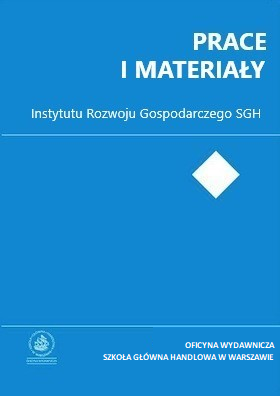Survey-based household inflation expectations - Are they valid? A multi-group confirmatory factor analysis approach
Main Article Content
Abstract
We present evidence that micro-level household inflation expectations are influenced by consumer confidence. To account for this impact, using multi-group confirmatory factor analysis, we measure the intertemporal consistency of a model comprising both consumer confidence and inflation expectations. We determine that the model exhibits the property of partial measurement invariance. Thus, we are able to account reliably for the influence of consumer confidence on inflation expectations and, simultaneously, to obtain corrected inflation expectations at the household level. It appears that, after correcting for the level of confidence, average inflation expectations at each point in time become significantly more similar to the average inflation expectations of professional forecasters and more correlated with average consumer confidence. Our analysis is based on household survey data from Poland's State of the Households' Survey (from 2000Q1 to 2012Q1), which is conducted in line with the European Commission's methodology.(original abstract)
Article Details
References
Ang, A., Bekaert, G., Wei, M. (2007). Do macro variables, asset markets, or surveys forecast inflation better?, Journal of Monetary Economics, 54 (4), 1163-1212.
Białowolski, P. (2014). Concepts of confidence in tendency survey research: An assessment with multi-group confirmatory factor analysis, Social Indicators Research, doi:10.1007/s11205-014-0736-1.
Białowolski, P., Kuszewski, T., Witkowski, B. (2014). Bayesian averaging of classical estimates in forecasting macroeconomic indicators with application of business survey data, Empirica, 41 (1), 53-68.
Białowolski, P., Węziak-Białowolska, D. (2013). The index of household financial condition, combining subjective and objective indicators: An appraisal of Italian households, Social Indicators Research, 118, 365-385.
Brown, T. A. (2006). Confirmatory factor analysis for applied research, New York, NY: The Guilford Press.
Browne, M. W., Cudeck, R. (1993). Alternative ways of assessing model fit, in Testing structural equation models, Newsbury Park, CA: Sage, 136-162.
Byrne, B. M., Shavelson, R. J., Muthen, B. (1989). Testing for the equivalence of factor covariance and mean structures: The issue of partial measurement invariance, Psychological Bulletin, 105 (3), 456-466.
Carroll, C. D., Fuhrer, J. C., Wilcox, D. W. (1994). Does consumer sentiment forecast household spending? If so, why?, The American Economic Review, 84 (5), 1397-1408.
Chou, C.-P., Bentler, P. M. (1995). Estimates and test in structural equation modelling, in R. H. Hoyle (ed.), Structural equation modelling: Concepts, issues and applications, Thousand Oaks, CA: SAGE Publications, 37-55 Coertjens, L., Donche, V., Maeyer, S. De, Vanthournout, G., Petegem, P. Van. (2012). Longitudinal measurement invariance of Likert-type strategy scales: Are we using the same ruler at each wave?, Journal of Psychoeducational Assessment, 30 (6), 77-87.
Costantini, M. (2013). Forecasting the industrial production using alternative factor models and business survey data, Journal of Applied Statistics, 40 (10), 2275-2289.
Davidov, E. (2008). A cross-country and cross-time comparison of the human values measurements with the second round of the European Social Survey, Survey Research Methods, 2 (1), 33–46.
Davidov, E., Schmidt, P., Schwartz, S. H. (2008). Bringing values back in the adequacy of the European Social Survey to measure values in 20 countries, Public Opinion Quarterly, 72 (3), 1-26.
European Commission (2006). European economy, Special Report no. 5: The joint harmonised EU programme of business and consumer surveys.
Gil-Alana, L., Moreno, A., De Gracia, F. P. (2012). Exploring survey-based inflation forecasts, Journal of Forecasting, 31 (6), 524-539.
Hox, J. (2002). Multilevel analysis. Techniques and applications. Mahwah, NJ: LEA Publishers.
Hu, L., Bentler, P. M. (1999). Cutoff criteria for fit indexes in covariance structure analysis: Conventional criteria versus new alternatives, Structural Equation Modeling, 6 (1), 1-55.
Kaplan, D. (2009). Structural equation modeling. Foundation and extentions.
Los Angeles: SAGE Publications.
Katona, G. (1946). Psychological analysis of business decisions and expectations, American Economic Review, 36 (1), 44-62.
Katona, G. (1947). Contribution of psychological data to economic analysis, Journal of the American Statistical Association, 42 (239), 449-459.
Lemmens, A., Croux, C., Dekimpe, M. G. (2007). Consumer confidence in Europe: United in diversity, International Journal of Research in Marketing, 24 (2), 113-127.
Marsh, H. W., Hau, K. T., Wen, Z. (2004). In search of golden rules: Comment on hypothesis-testing approach to setting cutoff values for fit indexes and dangers in overgeneralizing Hu and Bentler’s (1999) findings, Structural Equation Modelling, 11 (3), 320-341.
Millsap, R. E., Yun-Tein, J. (2004). Assessing factorial invariance in ordered-categorical measures, Multivariate Behavioral Research, 39 (3), 479-515.
Muthen, B., Asparouhov, T. (2002). Latent variable analysis with categorical outcomes: Multiple-group and growth modeling in Mplus, Mplus Web Notes, 4 (retrieved from http://www.statmodel.com/download/webnotes/ CatMGLong.pdf) Muthén, L. K., Muthén, B. O. (2012). Mplus user’s guide, Los Angeles, CA: Muthen&Muthen.
Nahuis, N. J., Jansen, W. J. (2004). Which survey indicators are useful for monitoring consumption? Evidence from European countries, Journal of Forecasting, 23 (2), 89-98.
Niemira, M., Klein, P. (1994). Forecasting financial and economic cycles, New York, NY: John Wiley & Sons.
Scheufele, R. (2011). Are qualitative inflation expectations useful to predict inflation?, Journal of Business Cycle Measurement and Analysis, 2 (1), 29-53.
Smets, F., Wouters, R. (2005). Comparing shocks and frictions in US and Euro Area business cycles: A Bayesian DSGE approach, Journal of Applied Econometrics, 20 (2), 161-183.
Steenkamp, J. E. M., Baumgartner, H. (1998). Assessing measurement invariance in cross-national consumer research, The Journal of Consumer Research, 25 (1), 78-90.
Vandenberg, R. J., Lance, C. E. (2000). A review and synthesis of the measurement invariance literature: Suggestions, practices, and recommendations for organizational research, Organizational Research Methods, 3 (1), 4-70.
Zarnowitz, V. (1992). Rational expectations and macroeconomic forecasts, in V. Zarnowitz (ed.), Business cycles: Theory, history, indicators, and forecasting, Chicago: University of Chicago Press, 462-491.
